The fine collection of prehistoric American Indian gold objects from Ecuador in the University Museum was found in 1912 by Sr. Pablo Isaias Sanches in the edge of an artificial mound on the island of Tola at the mouth of the Santiago River in the province of Esmeraldas.
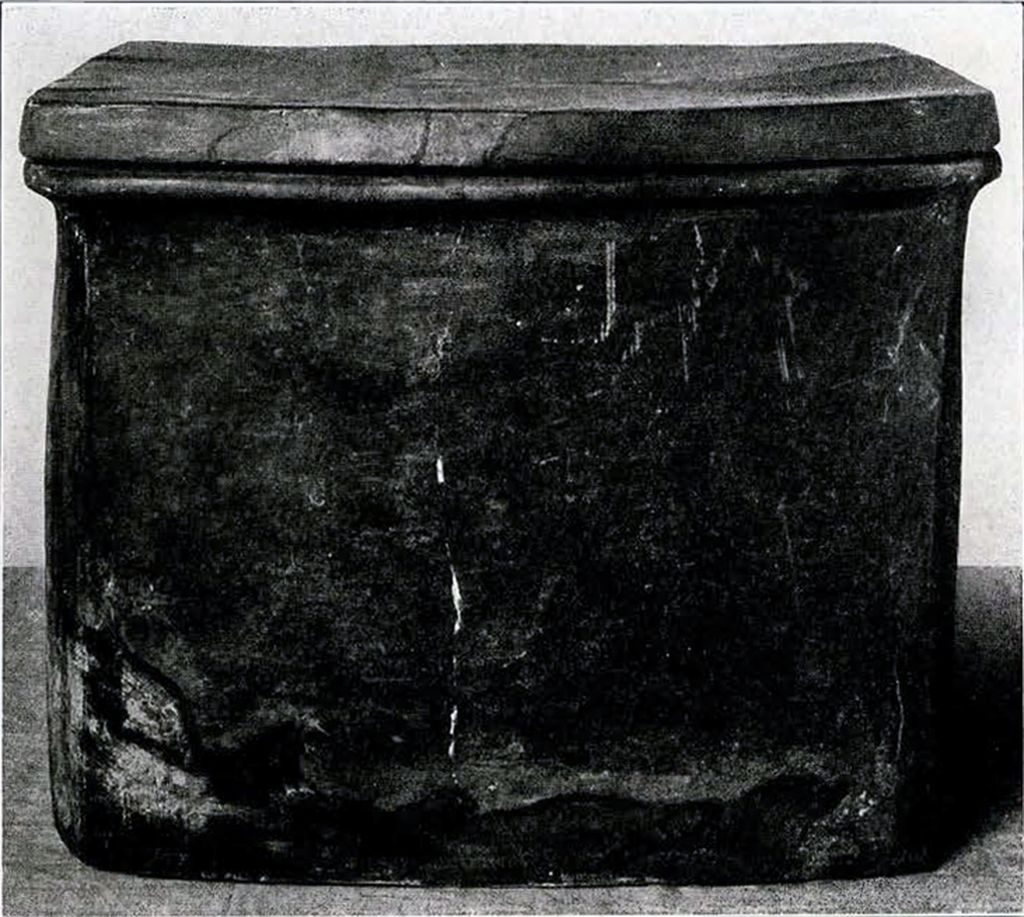
Museum Object Number: SA2830
Image Number: 20335
The island is low lying and swampy, and at high tide the sea covers a large section of it. The southern part is called La Lolita because it contains numerous artificial earthworks, some of them reaching the size of 25 feet in height and 150 feet in diameter. Sr. Sanches has developed this mound area as a cattle ranch and has given it the name of Pampa de Oro on account of the abundance of gold obtained by placer mining. Very little archaeological work has yet been done although some forty mounds have been cleared of the forest. Sr. Sanches dug a trench into one large mound and at a depth of 23 feet found a human skeleton buried in a sitting posture surrounded by pottery vessels. Among the numerous smaller objects in connection with the body was a most interesting golden egg having inside an uncut emerald.
While excavating at the side of a mound for the foundations of an extension of his brewery Sr. Sanches came upon a large clay box (Fig. 2) which proved to be a burial urn containing the skeleton of a child along with all the larger pieces of gold here illustrated.
Some description of the objects illustrated seems desirable. The large breastplate 14 inches across has a humanlike head embossed in the centre. The head, which was made separately by hammering, stands out 1¼ inches from the background to which it was attached by a splendid job of soldering. One of the rays had been broken off midway and repaired with a piece of gold differing in color by soldering on the joined pieces several short strips of soft gold and then beating them down. The head is probably that of the bat god, as the large canine teeth and holes instead of incisors are characteristics of that being. Four double headed alligators are repousséd on the background. They are made to appear very realistic with upturned snouts and triangles and dots to represent scales.
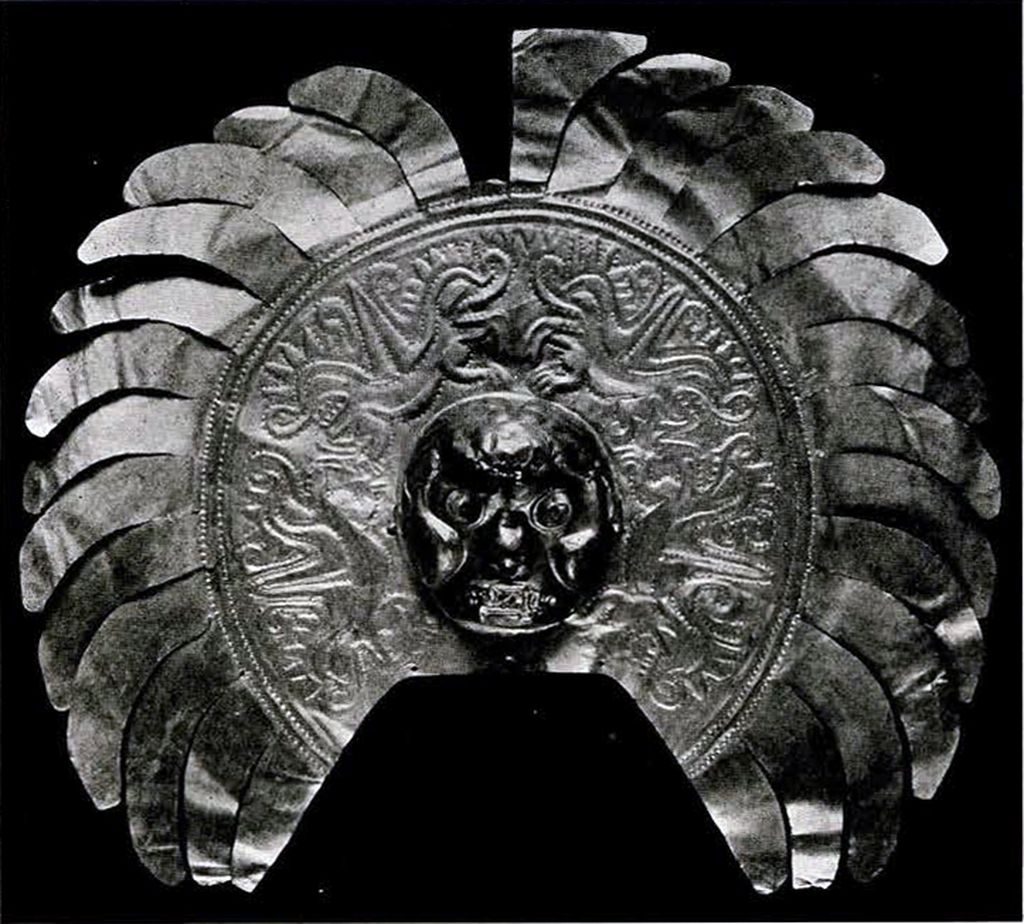
Museum Object Number: SA2831
Image Number: 20323
The second breastplate is 131⁄2 inches long and has two human heads at each end in repoussé. The head in the centre again appears to be that of the bat god. It was cast separately and soldered to the beaten plate. The nose pin has the appearance of passing through the septum but in reality two separate pieces were soldered on instead. (Fig. 4).
The bat god in Fig. 5 measures 9 r 2 inches across his wings. His head was cast in a slightly different coloured gold and soldered to the beaten body. His breasts are those characteristic of the bat while his hands are human.
Another example of the alligator design will be found in the beautifully decorated object in Fig. 6 which contains conventionalized heads of six alligators, two facing each other in the middle and one in each corner.
The two cufflike objects are identical, each 8 inches long and having ten rows of small bosses nine to the row. It is very doubtful if these were ever worn on the arms or legs because they are perforated at the four corners with large holes and around the smaller end with numerous small ones. The holes were made from the outside and hence the inside is very rough. The cuffs were more than likely attached by means of round headed gold nails to some wooden object, possibly an idol.
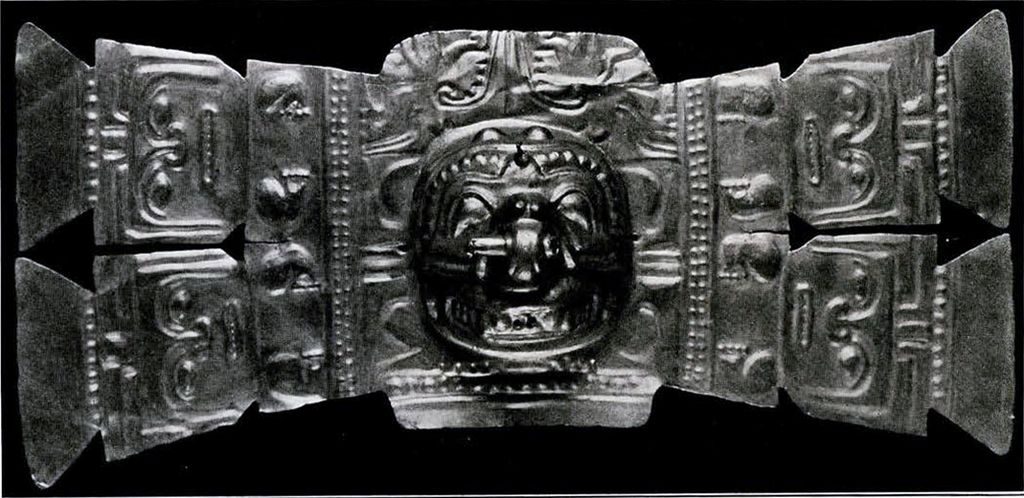
Museum Object Number: SA2832
Image Number: 20328
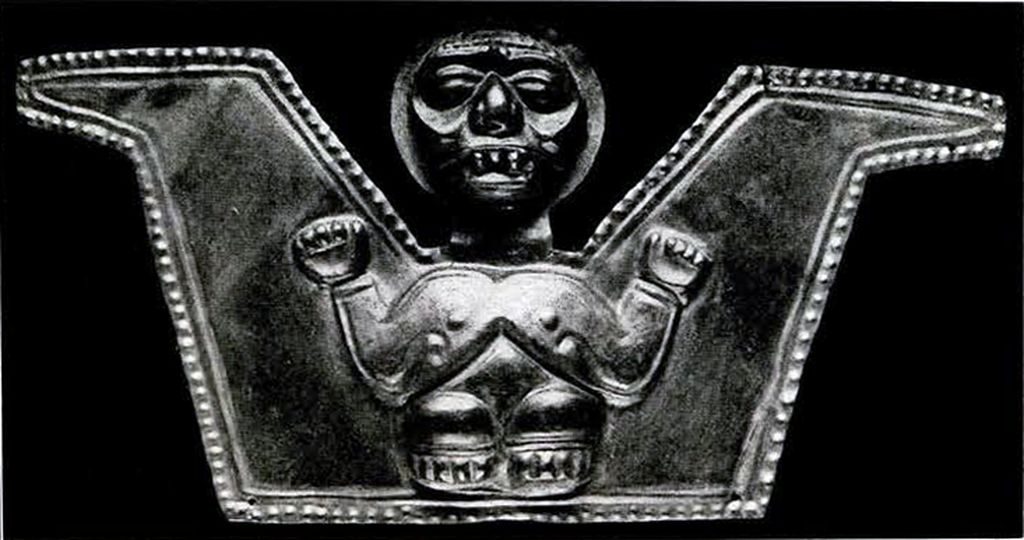
Museum Object Number: SA2833
Image Number: 20329b
There are nearly a thousand thin quadrangular pieces of gold, five-eights inch by one inch, perforated at the corners and evidently intended for sewing on garments. From the position in which they were found, connected with the skeleton of the child, Sr. Sanches thought they had been sewn on the burial shroud of the child. The decorated ones served as a fringe.
The beltlike sheets of gold having large bangles attached to them with gold wire are a mystery. The largest of the three pieces is 20 inches long and has fourteen bangles attached to it. One guess is as good as another as to their use. They contain perforations for sewing or nailing them fast.
Besides these larger pieces there are numerous interesting smaller bits of jewelry. Such as two wheelshaped telescopic earrings in filigree work; two elaborately made earrings with hooks for suspension; nose ornaments made from a beaten nugget, some are hollow while others have a copper core plated with gold; small round decorated boxes with soldered ends; coils of gold wire of different sizes and other nondescript objects of unknown use.
In the lowlands of the island wherever excavations are made gold is found in paying quantities and along with it great quantities of pottery fragments are obtained in the mud and decayed vegetable material to a depth of five or six feet. While panning for gold the natives find, besides the natural gold sands, thousands of very minute finely worked objects or fragments of jewelry in an immense variety of forms and designs. Fig. 9 will give some idea of the two or three thousand specimens in our collection. Among them are nose, ear, lip and cheek ornaments; awls, needles and fishhooks; tacks and nails, with heads and without, of various forms and sizes; gold rings and pendants with stone settings; minute bangles attached to other jewelry; miniature masks of plain beaten gold and of delicate filigree work. The use of many of these things is obvious and that of others may be inferred from the stories of the conquerors who reported that the Indians’ faces were sown with nails of gold.
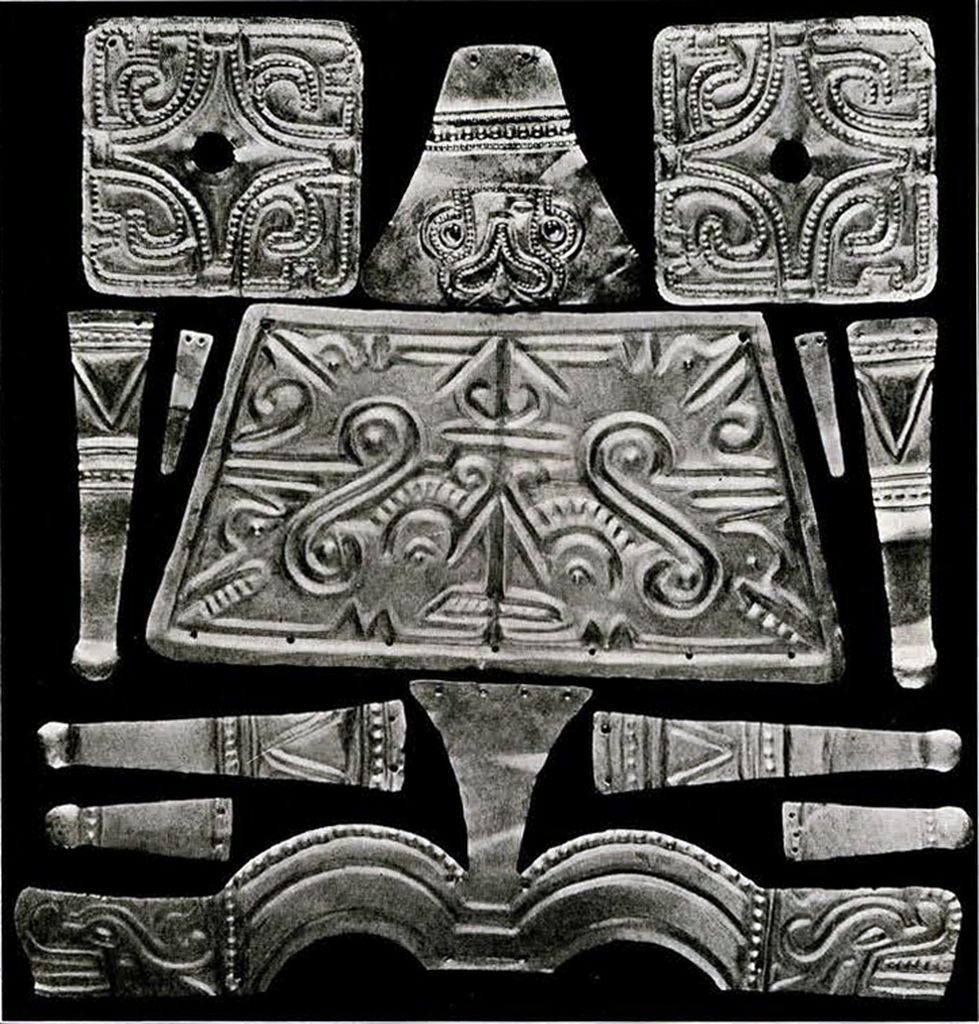
Museum Object Numbers, From Top Left: SA2835 / SA2837 / SA2835 / SA2841A / SA2842 / SA2834 / SA2842 / SA2841B / SA2841C / SA2841D / SA2842 / SA2842 / SA2836
Image Number: 20330a, 20330b
There is evidence that the ancient Indian workmen of Esmeraldas were metallurgists of marked ability. They were the only people who manufactured platinum jewelry. In our collection will be seen objects of pure platinum, objects with platinum background set with tiny balls of gold fused to form a border, and objects with one side platinum and the other gold.
The characteristic feature of these objects is their microscopic size. Large objects are found in the mounds as is shown by our plates but nothing of any size has been found in the washings.
The origin of this gold is at present a great conundrum. It has the appearance of a junkshop where fragments have been collected for reworking. Yet a very large per cent are perfect specimens. Material of similar character is found in several places along the shore where rivers enter the sea. All these rivers carry down native gold, and the Indians washing for it find the worked specimens in their pans. These deposits do not have the appearance of refuse heaps or village sites but more that of redeposited material under the action of water. However, if it was so redeposited, what has become of the larger pieces of gold? Sometimes entire pots are found and human bones which show no signs of rough usage. The whole problem will require careful scientific work for a satisfactory solution.
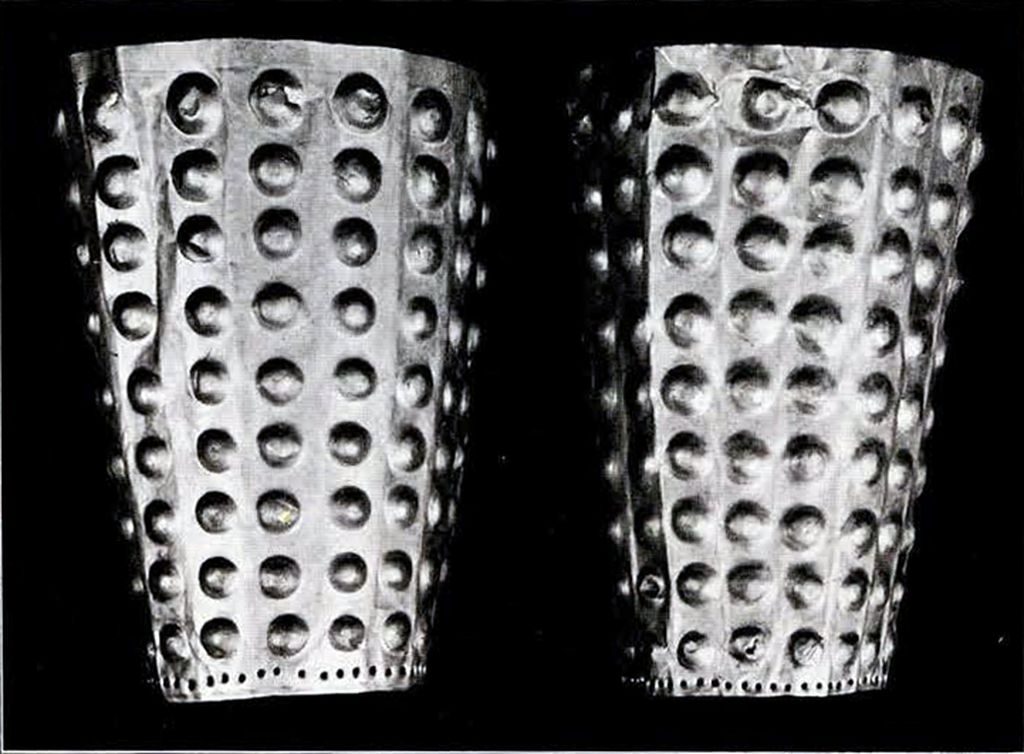
Museum Object Numbers: SA2852A/ SA2852B
Image Number: 20332
Interest attaches to these Ecuadorean collections because of their artistic value, their suggestive designs, and their evidence of mechanical skill and metallurgical knowledge attained by the ancient smiths. No other people worked platinum and none made so much delicate jewelry. Many of the designs are so similar to those found in Central America and so unlike any in Peru or Colombia that one is inclined to believe there has been a direct contact between these two widely separated cultures. The bat god in gold is common in both areas.
The alligator designs in repoussé on the gold breastplates are strikingly similar to those found painted on the so called “alligator ware” from Chiriqui. Very realistic alligators in repoussé are found on the large gold breastplates from Colombia, whereas in Esmeraldas and Chiriqui the animal is highly conventionalized. The common designs on the pottery of the two regions are also quite similar. Another very important bit of evidence has come to light touching upon a curious custom formerly practiced in the two areas. I refer to the custom of decorating the incisor teeth by inlays of jadeite, turquois, gold, etc., found in Mexico, Central America and Ecuador but not found elsewhere. Until more archeological work has been done in Colombia and Panama it will be impossible to determine whether the contact between Esmeraldas and Chiriqui came by way of the land or across the sea. Here is an important field for careful research.
W. C. F.
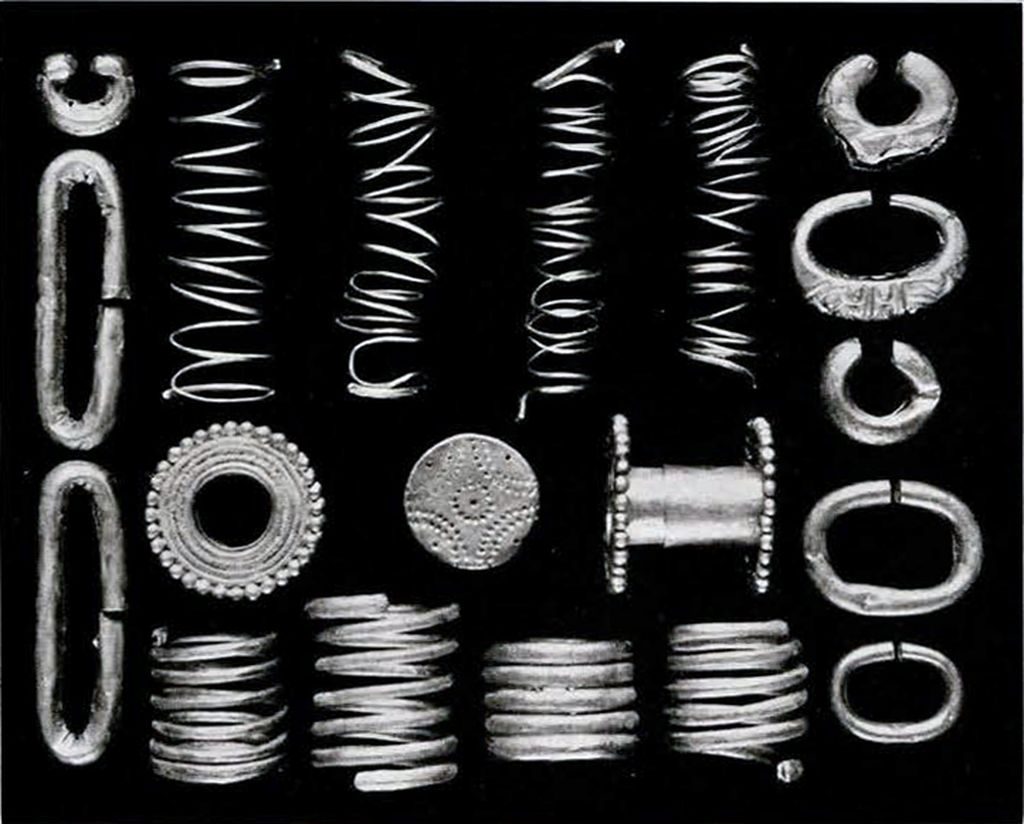
Museum Object Numbers: SA2875 (Top Left Nose Ring) / SA2844 (Left Links) / SA2848 (Fine Coils) / SA2854A, SA2854B (Ear Ornament with Concentric Circles, Front and Side) / SA2857 (Repousse Cylinder) / SA2855A , SA2855B, SA2855C ( Heavy Coils) / SA2847 (Top Right Nose Ring) / SA2845 (Right Nose Ring, Second From Top) / SA2862 (Right Bottom Nose Rings)
Image Number: 20333
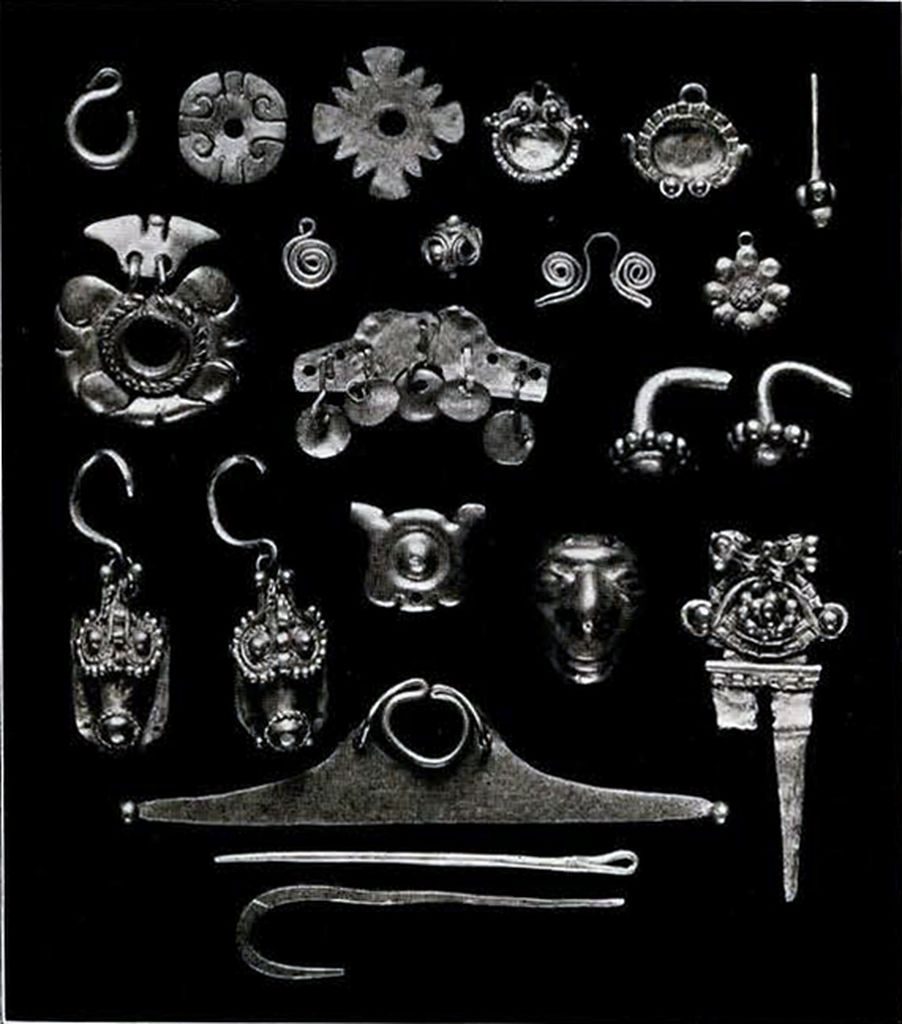
Museum Object Numbers: SA2864 (Nose Ornament with Bird Figure Atop, Left) / SA2867A, SA2867B (Hook Suspended Earrings, Left) / SA2859 (Nose Bar with Knobs at Ends, Bottom) / SA2870A (Needle, Bottom) / SA2870D (Fishhook, Bottom) / SA2871 (All Others)
Image Number: 20334

